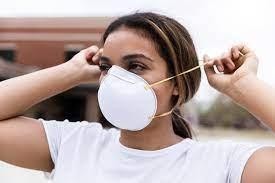A nurse is planning care for a client who requires airborne precautions. Which of the following actions should the nurse take?
Stand 1.8 m (6 feet) away from the client.
Allow the client to ambulate in the hall.
Provide a positive-pressure airflow room.
Wear an N95 respirator mask.
The Correct Answer is D
A. Standing 1.8 m (6 feet) away from the client is not sufficient for airborne precautions.
Proper respiratory protection is required, such as an N95 mask.
B. Allowing the client to ambulate in the hall is not a specific action related to airborne precautions. If the client needs to leave their room, they should wear a mask to prevent the spread of airborne particles.
C. A positive-pressure airflow room is not typically required for airborne precautions.
However, ensuring proper ventilation in the room is important.
D. Airborne precautions are required for clients with illnesses that spread via small droplets or dust particles that can remain in the air for extended periods. This includes diseases like tuberculosis, chickenpox, and measles. The nurse should wear an N95 respirator mask to provide protection against inhaling these particles.

Nursing Test Bank
Naxlex Comprehensive Predictor Exams
Related Questions
Correct Answer is ["A","B","D","E"]
Explanation
A. More difficulty seeing due to a greater sensitivity to glare is a common age-related change in vision.
B. Dehydration of intervertebral discs can occur with aging, leading to decreased flexibility and potentially contributing to back pain.
C. While systolic blood pressure may increase with age, decreased systolic blood pressure is not a typical age-related change.
D. Decreased cough reflex is an expected change, which can lead to an increased risk of respiratory infections in older adults.
E. Decreased bladder capacity is an expected age-related change due to changes in the bladder muscles and elasticity of the tissues. This can contribute to increased frequency of urination in older adults.
Correct Answer is A
Explanation
A. Determining the location of the pain is the first step in assessing and managing a client's pain. It helps the nurse gather important information about the nature and potential causes of the pain.
B. Administering the medication may be necessary, but it should come after the nurse has assessed the location and characteristics of the pain to ensure the correct medication and dosage are given.
C. Repositioning the client can be important for comfort and pain relief, but it should come after the nurse has assessed the location of the pain to determine the best position for the client.
D. Reviewing the effects of the pain medication is important, but it should come after the nurse has administered the medication. It is essential to first address the client's request for pain relief by assessing the pain location and administering the appropriate
medication.
Whether you are a student looking to ace your exams or a practicing nurse seeking to enhance your expertise , our nursing education contents will empower you with the confidence and competence to make a difference in the lives of patients and become a respected leader in the healthcare field.
Visit Naxlex, invest in your future and unlock endless possibilities with our unparalleled nursing education contents today
Report Wrong Answer on the Current Question
Do you disagree with the answer? If yes, what is your expected answer? Explain.
Kindly be descriptive with the issue you are facing.
